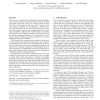431 search results - page 80 / 87 » Using Formal Methods to Reason about Architectural Standards |
108
click to vote
TOPLAS
2008
14 years 11 months ago
2008
act Interpretation C. BERNARDESCHI, N. DE FRANCESCO, G. LETTIERI, L. MARTINI, and P. MASCI Universit`a di Pisa Bytecode verification is a key point in the security chain of the Jav...
187
Voted
ICFP
2009
ACM
16 years 9 days ago
2009
ACM
We present a new approach for constructing and verifying higherorder, imperative programs using the Coq proof assistant. We build on the past work on the Ynot system, which is bas...
ICFP
2006
ACM
15 years 11 months ago
2006
ACM
The development of design patterns in object-oriented programming aims at capturing good software design in a re-usable generic form. However, design patterns are not expressible ...
CORR
2002
Springer
14 years 11 months ago
2002
Springer
for data abstraction and justifies reasoning by simulation. Representation independence has been shown for a variety of languages and constructs but not for shared references to mu...
110
Voted
SPAA
2009
ACM
15 years 8 months ago
2009
ACM
Abstract. At-most-once semantics is one of the standard models for object access in decentralized systems. Accessing an object, such as altering the state of the object by means of...

